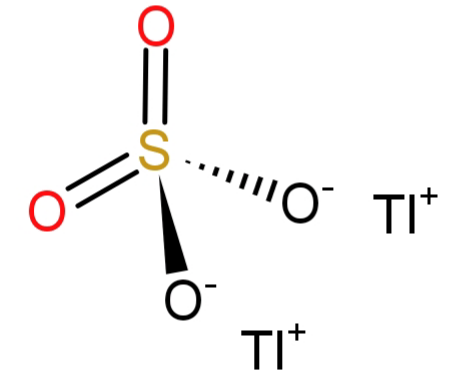
Formula for the following compound Thallium (I) sulphate is $T{l_2}S{O_4}$ .
A.True
B.False
Answer
582k+ views
Hint:
Thallium has 3 valence electrons (2 in 6s and 1 in 6p) and exhibits mostly (+1) oxidation state while sulphate ($S{O_4}^{ - 2}$) exhibits (-2) oxidation state.
Complete step by step answer:
-Thallium (Tl) has an atomic number of 81 and belongs to the Boron (B) group. It belongs to the 13th group and 6th period. Hence, its electronic configuration is: $\left[ {Xe} \right]4{f^{14}}5{d^{10}}6{s^2}6{p^1}$.
We can see from the configuration that Tl has the ability to lose 1 electron from the outermost subshell of 6p and attain a more stable state, thus exhibiting (+1) oxidation state. It can also lose 3 electrons from the outermost shell (6s and 6p). Thus thallium (Tl) can exhibit (+1) and (+3) oxidation states.
-Thallium (I) sulphate is also known as thallous sulphate is a sulphate salt of thallium in the common (+1) oxidation state as shown by Roman numeral (I).
-It is formed by the reaction of sulphuric acid with thallium metal, which is followed by crystallisation.
-Thallium sulphate is colourless, tasteless, odourless and highly toxic (hence used in insecticides, rodenticides and rat poisons. It gains its toxicity due to $T{l^{ + 1}}$ ion.
-Since the question says the name of the formula to be: Thallium (I) sulphate. The number (I) here shows the oxidation state of thallium atom, which is 1. And we all know that the sulphate has the molecular formula of $S{O_4}^{ - 2}$ and has an oxidation state of (-2). To satisfy or neutralise the (-2) charge of sulphate we will need a (+2) charge, but thallium has (+1) charge. So, we will require 2 atoms of thallium. Hence the molecular formula would be: $T{l_2}S{O_4}$.

The statement is true and the correct option is: (A) True.
Note:
Although thallium can exhibit (+1) and (+3) oxidation states. It mostly prefers only (+1) because the 2 electrons from 6s subshell are relatively stable and much more difficult to remove than the 6p electron due to inert pair effect.
Thallium has 3 valence electrons (2 in 6s and 1 in 6p) and exhibits mostly (+1) oxidation state while sulphate ($S{O_4}^{ - 2}$) exhibits (-2) oxidation state.
Complete step by step answer:
-Thallium (Tl) has an atomic number of 81 and belongs to the Boron (B) group. It belongs to the 13th group and 6th period. Hence, its electronic configuration is: $\left[ {Xe} \right]4{f^{14}}5{d^{10}}6{s^2}6{p^1}$.
We can see from the configuration that Tl has the ability to lose 1 electron from the outermost subshell of 6p and attain a more stable state, thus exhibiting (+1) oxidation state. It can also lose 3 electrons from the outermost shell (6s and 6p). Thus thallium (Tl) can exhibit (+1) and (+3) oxidation states.
-Thallium (I) sulphate is also known as thallous sulphate is a sulphate salt of thallium in the common (+1) oxidation state as shown by Roman numeral (I).
-It is formed by the reaction of sulphuric acid with thallium metal, which is followed by crystallisation.
-Thallium sulphate is colourless, tasteless, odourless and highly toxic (hence used in insecticides, rodenticides and rat poisons. It gains its toxicity due to $T{l^{ + 1}}$ ion.
-Since the question says the name of the formula to be: Thallium (I) sulphate. The number (I) here shows the oxidation state of thallium atom, which is 1. And we all know that the sulphate has the molecular formula of $S{O_4}^{ - 2}$ and has an oxidation state of (-2). To satisfy or neutralise the (-2) charge of sulphate we will need a (+2) charge, but thallium has (+1) charge. So, we will require 2 atoms of thallium. Hence the molecular formula would be: $T{l_2}S{O_4}$.

The statement is true and the correct option is: (A) True.
Note:
Although thallium can exhibit (+1) and (+3) oxidation states. It mostly prefers only (+1) because the 2 electrons from 6s subshell are relatively stable and much more difficult to remove than the 6p electron due to inert pair effect.
Recently Updated Pages
Why are manures considered better than fertilizers class 11 biology CBSE

Find the coordinates of the midpoint of the line segment class 11 maths CBSE

Distinguish between static friction limiting friction class 11 physics CBSE

The Chairman of the constituent Assembly was A Jawaharlal class 11 social science CBSE

The first National Commission on Labour NCL submitted class 11 social science CBSE

Number of all subshell of n + l 7 is A 4 B 5 C 6 D class 11 chemistry CBSE

Trending doubts
Differentiate between an exothermic and an endothermic class 11 chemistry CBSE

10 examples of friction in our daily life

One Metric ton is equal to kg A 10000 B 1000 C 100 class 11 physics CBSE

Difference Between Prokaryotic Cells and Eukaryotic Cells

State the laws of reflection of light

Explain zero factorial class 11 maths CBSE




